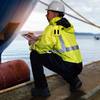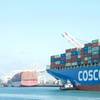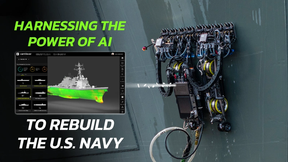Project partners BHP, Fortescue, Mitsui O.S.K. Lines (MOL), Rio Tinto, SDARI, U-Ming, Woodside, and DNV GL presented the results from stage one of their “Green Corridor” joint industry project (JIP), which demonstrated the commercial potential and technical feasibility of bulkers fueled by liquefied natural gas (LNG) in the iron ore and coal trade between Australia and China. The result is an LNG-fueled Newcastlemax design which is in the process of receiving Approval in Principle (AiP) from DNV GL.
The idea of developing LNG-fueling infrastructure for the vessels operating on the Australia–China iron ore and coal trade route has been contemplated by major charterers, ship owners and operators for many years.
As LNG production has climbed, especially in Australia, and in recognition of the International Maritime Organization’s (IMO) upcoming restrictions on sulphur emissions, the option of LNG as a single-system solution for emissions compliance has become ever more attractive.
“This JIP has shown that by bringing together partners from across the industry to investigate alternative compliance options that account for market and trade route characteristics, such as safety and ease of operation, cargo and fuel flexibility, energy efficiency and economic viability, we can arrive at unique solutions that fulfill owners and operators’ requirements, as well as being in full compliance with international rules and regulations,” said Morten Løvstad, DNV GL – Maritime Business Director Bulk Carriers. “By having both charterers and ship owners as active partners in the JIP, we are also optimistic that this new design will materialize into firm orders in the near future.”
Chinese ship designer SDARI developed the design of the 210,000 dwt Newcastlemax bulk carrier based on their highly energy efficient Green Dolphin design.
Dual fuel engines were quickly decided upon by the JIP partners, as this is a mature technology with multiple suppliers offering solutions, and the dual fuel design providing operational redundancy.
Based on fuel consumption analyses an LNG fuel tank size of approximately 6,000 m3 was found to be optimal, with bunkering in Australia for the round-trip. Several locations for the LNG fuel tank were considered, and finally the optimal solution was found – with the two LNG fuel tanks placed directly above the engine room and submerged a few meters below the main deck. This innovative design offers protection for the fuel tanks, enhances fire protection, and does not reduce the cargo carrying capacity, even for volumetric cargoes such as coal.
“We hope this mutual collaboration will contribute to building the positive momentum of the industry to meet environmental and social requirements. We would like to renew our commitment to promote the further development of environmental technologies to achieve more sustainable ocean transportation,” said Toshiaki Tanaka, Managing Executive Officer, Director General, Dry Bulk Business Unit from Mitsui O.S.K. Lines, Ltd.
“An important part of the JIP was conducting the financial feasibility study for the design,” said Mike Utsler, Woodside Chief Operations Officer. “We looked at a wide range of capital and operational costs, including LNG and low sulfur fuel oil price sensitivities, as well as conducting a high-level bunker supply chain assessment. Based on this we found that, under the most realistic scenario, the payback period for the design was under 10 years, and under the optimistic projection just 6.7 years.”
“This joint industry project has shown us the power of a collaborative approach to a regulatory step change,” said David O'Brien, Principal Advisor, Rio Tinto. “Outside the JIP, we can be partners, competitors, suppliers and principals but inside the JIP, the common goal is clear and has shown to be achievable. We strongly support this type of collective industry approach when faced with an uncertain target.”
“As a member of the global shipping community, U-Ming continuously explores the latest technology and business models to enhance the protection of the environment,” said C.K. Ong, President of U-Ming Marine Transport Corp. “The 'Green Corridor' JIP is a collaboration of expertise and competence from like-minded people working towards a common goal. We truly believe the Green Dolphin 210 would result in an outstanding ecological footprint and business performance. By teamwork, we go further.”
According to DNV GL, the new, innovative Newcastlemax design developed in the "Green Corridor" JIP offers unique solutions for cost efficient, safe and flexible operations. By gathering key stakeholders representing the wider value chain of iron ore and coal transportation, a more robust, commercially viable and safe LNG-fueled bulk carrier design has been developed, to a stage where it is ready to serve as the outline specification for newbuilding orders in 2017.















